World War 1: The Great War
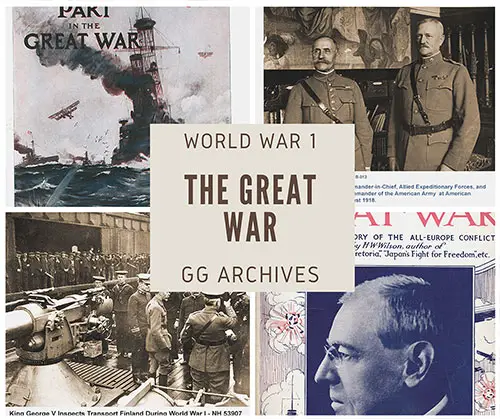
Extensive collection of WWI materials, including information and photographs of Camp Pike, Camp Grant, Camp Dix, Camp Dodge, and others. Unique coverage of the WW1 Draft, including Draft Registrations, Unit Histories, French Money, and Correspondence from King George V.
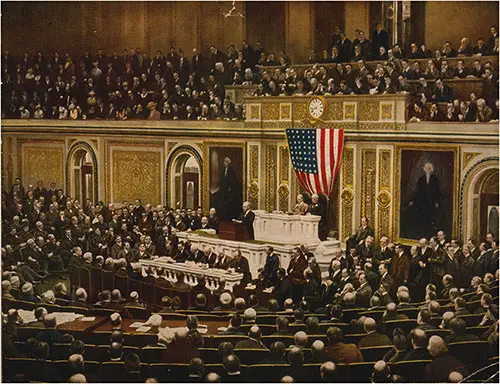
Great Britain and France had been fighting since the beginning of the war in 1914, while Italy joined in May 1915 and the United States in April 1917. On the other hand, all the European Powers had reached, if not passed, their meridian of strength, whereas the United States could, with a corresponding effort, raise her forces to over ten million.
- Prelude to War: The Zimmermann Telegram
- Origin of the Great War
- Britain Joins the War
- The United States Intervenes
- President Wilson's War Address
- President Wilson's Address as the US Joins The Great War
- America Joins the War
- Why We Went to War
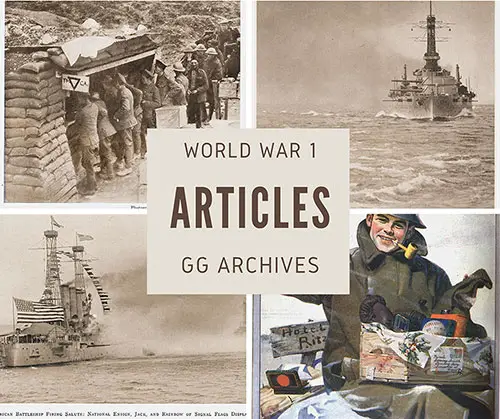
As the 1914–1918 conflict came to be known, the Great War became a world war indeed as it drew in Japan, British colonies in the Pacific, and European colonial holdings throughout Africa, Asia, and North America.
- WW1 Timeline 1914-1918
- The Campaigns Against Russia 1914-1917
- The Christmas Truce of 1914
- Chemical Warfare - "Gas" In This War
- Arrival of American Expeditionary Force Divisions
- Feeding the Men on the Front Lines During World War I
- Americans Arrive in Paris - Homeward Bound Americans
- Chronology of WW1 American Operations
- Food Supplies Forwarded to German Prison Camp For Captured American Soldiers
- The Gem of the Ocean - Our American Navy
- The Immigrant Army: Immigrant Service Members in World War I
- In The Battles of the Great War
- A National War Service Newspaper
- Personnel of the AEF in France
- Review of Camp Dodger and The Bayonet Camp Newspapers
- RMS Laconia Torpedoed by German U-Boat
- Sinking of the Cunard "Laconia" - First-Hand Account by Floyd Gibbons
- The Sinking of the American Destroyer Jacob Jones
- The American People and The Great War
- War News Not Publishable
- What Does It Mean to Be an American?
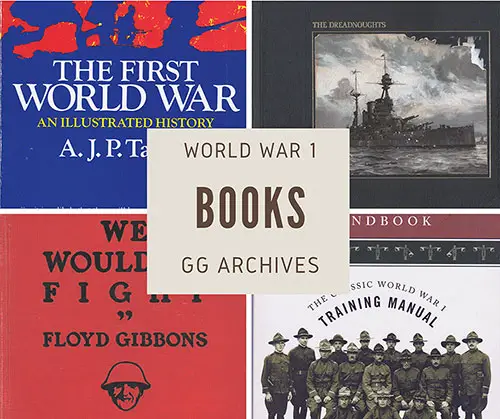
Explore the captivating history of World War 1. The First World War was one of the most devastating conflicts in our history. Our collection features rare and insightful books, primarily from an American perspective.
- 346th Infantry Historical Notes 1917-1919
- 351st Infantry Historical Notes 1917-1919
- The 88th Division in the World War of 1914-1918
- American Armies and Battlefields in Europe
- America's Part in the World War
- And They Thought We Wouldn't Fight
- Army Service Records of the First World War
- B.E.F. The Whole Story of the Bonus Army
- Bluejackets Manual of the United States Navy, 1918 Edition
- Camp Devens: Described and Photographed
- Camp Zachary Taylor Pictorial Souvenir
- Cartographic Records of the American Expeditionary Forces, 1917-21
- Churchill 1914-1918 War Leader Book No. 23
- Collier's Photographic History of the European War
- Concise History of World War 1
- The Dreadnaughts
- Exploring the Lusitania
- Field Service Regulations United States Army - 1914 (Updated 1917)
- The First World War: An Illustrated History
- Forging the Sword: The Story of Camp Devens
- Handbook of Federal World War Agencies and Their Records 1917-1921
- History of the Great War, Volumes 1-3
- History and Rhymes of the Lost Battalion
- Infantry Drill Regulations 1911 - United States Army
- The Infantry Soldier's Handbook: The Classic World War I Training Manual
- Lusitania: An Illustrated Biography of the Ship of Splendor
- The Lusitania Case
- The Lusitania's Last Voyage
- The Lusitania Story
- Manual for NCOs and Privates of Infantry US Army - 1917 Edition
- Manual for Soldiers in France: In Town and Field Service
- Minnesota in the War with Germany, Volume 1
- The Navy's First Enlisted Women: Patriotic Pioneers
- Order of Battle, Volume 1: American Expeditionary Forces
- Order of Battle, Volume 2: American Expeditionary Forces: Divisions
- Order of Battle, Volume 3, Part 1: Organization and Activities of the War Department
- Order of Battle, Volume 3, Part 2: Territorial Departments, Tactical Divisions, Posts, Camps, and Stations
- Order of Battle, Volume 3, Part 3: Directory of Troops
- The First World War: An Illustrated History
- The Pick: 3rd Officers Training Camp at Camp Devens
- Pictorial History of the World's Greatest War
- The United States Naval Railroad Batteries in France
- Verdun: Vision and Comprehension - The Battlefield and Its Surroundings
- The World's Greatest War: The Triumph of America's Army and Navy - Peace Treaty Edition
- World War One: 1917 Soldiers
- World War One: 1918 Soldiers
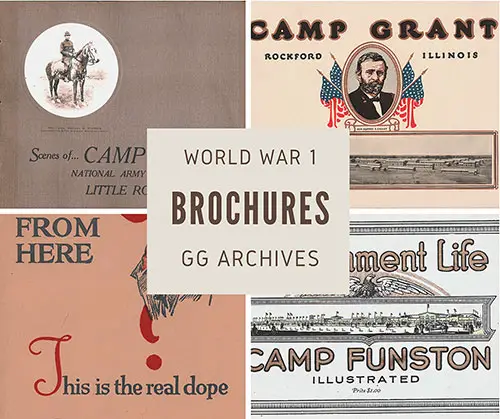
World War 1 Brochure Collection
Our Brochures cover a wide range of subjects about World War 1. The Topics include important addresses by VIPs, recruitment, and valuable information for discharged soldiers.
- Address to Soldiers at Camp Dix
- America Entangled - The Story of the Lusitania
- Army/Navy Recruitment Guide - 1917 Edition
- Camp Funston Illustrated - Cantonment Life
- Camp Grant Pictorial History
- Our Sons at Camp Dodge
- Scenes of Camp Pike, National Army Cantonment
- To The Homeward Bound Americans
- Valuable Information for Discharged Soldiers
- Where Do We Go From Here? This Is The Real Dope
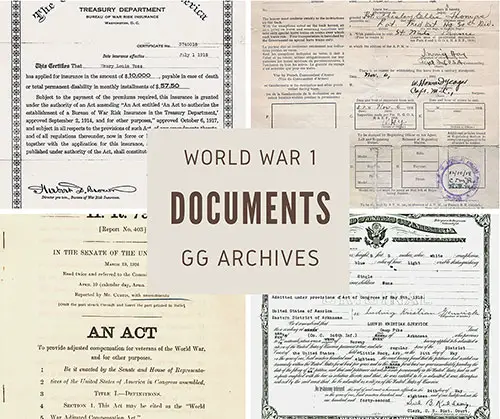
Our collection includes many papers genealogists and family historians will come upon during their research. Our extensive document collection is helpful for students studying the great war and teachers seeking primary source documents to enhance their lessons.
- Floyd Gibbons Correspondent Pass
- Leaves of Absence, Passes, and Furloughs: General Orders No. 6 HQ AEF, France - 1918
- Leave Permit for American Soldier in France
- Joint Resolution Declaring A State of War Exists Between Germany and the US - 2 April 1917
- Letter from General Foch to Floyd Gibbons - 1918
- Letter from General John J. Pershing to Floyd Gibbons - 1918
- Letter from General Pétain to Floyd Gibbons, 1918
- World War I French Currency
- WW1 Soldier's Diary Extracts - 1917-1918
- Soldiers Pay Record Book - 1918
- Third Army Corps Cablegrams - 1918
- American Legion Membership Card
- US Army Promotions and Appointment Certificates
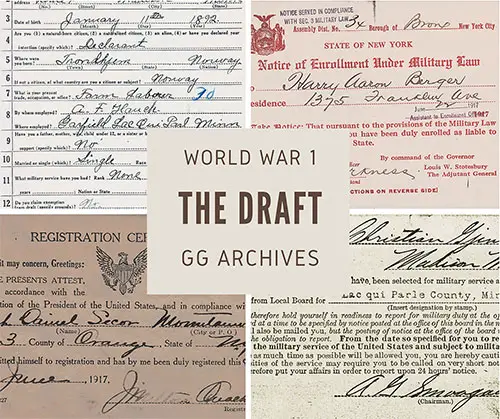
World War 1 Draft / Conscription
Our collection includes draft and selective service documents and photographs, including Notice of Certification to District Board, Notice of Enrollment Under Military Law, Draft Registration Cards, Registration Certificates, Questions & Answers, and more.
- Bulletin of Information for Persons Registered for the Draft - 1917
- World War 1 Draft Registration Cards
- Important Notice to All Men Selected for Military Service - 1918
- Notice of Call and to Appear for Physical Examination - 1917
- Notice of Certification For Military Duty to District Board - 1917
- The Proclamation for the First Draft Registration, 1917
- Joint Resolution for Second Draft Registration, 5 June and 24 August 1918
- Proclamation for the Third Draft Registration, 12 September 1918
- The World War One Draft - Reporting of the First Draft Lottery - 20 July 1917
- The Selective Draft - 69 Questions and Answers - World War 1
- The Selective Service System - Its Aims and Accomplishments - Its Future - 1917
- Three Draft Registrations Required During World War 1
- State of New York Military Census and Inventory of 1917
- State of New York Notice of Enrollment Under Military Law - 1917-06-22
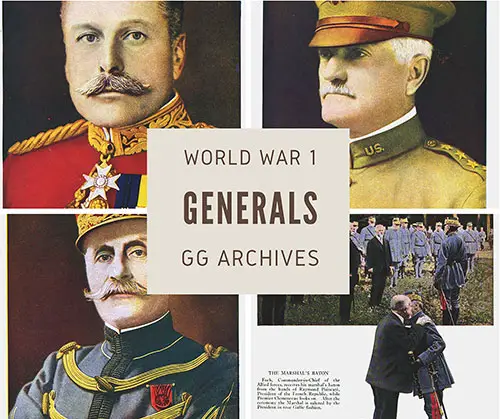
Famous Generals of World War 1
Biographies of famous generals on the Great War including Joffre, French, Foch, Haig, Pershing, Pétain and Curieres de Castelnau. These allied commanders were instrumental in achieving a victorious outcome culminating with the Armistice on 11 November 1918.
- General "Papa" Joffre: Hero of the Battle of the Marne
- Sir John French: The Man Who Led the First British Army
- Ferdinand Foch: Commander-In-Chief of the Allied Forces
- Sir Douglas Haig: Commander of the British Forces in France
- John J. Pershing: Commander of the Army of the United States
- Henri P. Pétain: Defender of Verdun
- Edouard de Curieres de Castelnau: The Defender of Nancy
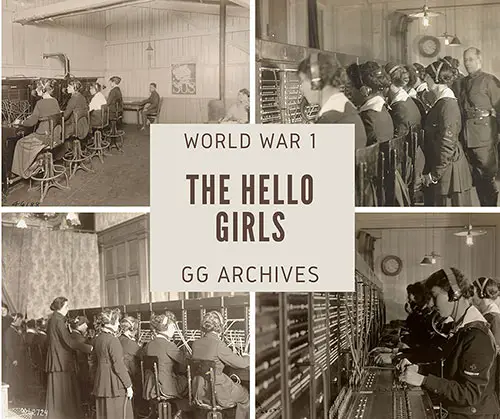
The Hello Girls Telephone Operators of World War I
Our comprehensive collection of articles, photographs, books, documents, congressional bills, and more provides an extensive volume of research materials for genealogists and students.
- WW1 Photos: The "Hello Girls" Signal Corps Telephone Operators
- First Unit of Telephone Operators Ready for France - 1918
- Second Unit of Telephone Operators Ready for France - 1918
- Third Unit of Telephone Operators Arrive in France - 1918
- Fourth Unit of Telephone Operators Arrive In France - 1918
- Fifth Unit of Telephone Operators Arrive in France - 1918
- Sixth Unit of American Telephone Operators Has Arrived in France - 1918
- Seventh Unit of Telephone Operators Demobilizes - 1919
- 223 Women of the Signal Corps Telephone Operators that Served Overseas
- Adele Hoppock and En Route to France - 1918
- The Adventures of Miss Elizabeth Horsman and Miss Helen Carey - 1918
- American "Hello Girls" in France Enjoy High Life
- American Telephone Girls Well Cared for in France
- American Telephone Operators Aid Victory
- Application for Membership in Telephone Unit in France
- Secretary of War Baker Congratulates Telephone Operators
- Bay Area Girls at Front During Great Drives
- Berlin Girl to Go as Phone Operator
- Birth of the AEF Signal Corps Girls
- Black Jack's Girls
- Blue Triangle Follows the Switchboard
- Brave Girl Soldiers of the Switchboard
- Brief History of the Signal Corps Female Telephone Operators
- Chicago Telephone Girls Heroines "Over There"
- The Christmas Party at Camp Upton
- Congressman Cleaver Introduces Bill to Award Congressional Gold Medal to the 'Hello Girls' of WWI
- Company of Switchboard Soldiers See Service in France
- Facts Surrounding the Enlistment and Service of the Signal Corps Telephone Operators
- First American Telephone Girls in France
- First Washington Girl Arrives in French Territory
- For the Wire Men and Girls in France
- Four of The Michigan Telephone Company's "Returned Soldiers"
- General Squier in Charge of Aviation and Signal Corps
- Miss Helen Carey, Telephone Operator Off for France
- "Hello-Girls" Are Going "Over There" To Help Link Up the Army's Nerve-Fibers
- Hello Girls of World War I
- "Hello" Heroines - Telephone Operators of the Great War Era - 1920
- Hello—Over There! - Our Telephone Girls Take On Paris
- How the Signal Corps Girls Stayed on the Job
- How the Signal Corps Organized 100 Girls
- How the Telephone Girls Performed in France
- HR 1953-Hello Girls Congressional Gold Medal Act of 2019
- I Was a "Hello Girl"
- Impressions of the A. E. F. by Signal Corps Operator O'Rourke
- Information Relative to Telephone Operators for Duty in France
- A Letter from a Fifth Unit Telephone Operator
- Letter from Adele Hoppock Mills to Senator Vandenburg - 1935
- Letter from "Hello Girl" Miss Adele Hoppock - 1918
- Letter from Major Coles to Washington State Bonus Board - 1921
- Letter Home from Signal Corps Telephone Operator in France - 1918
- Life of Our Telephone Operators in France
- Long Distance Operators Off for France
- Military Funeral of Telephone Operator Cora Bartlett - 1919
- Miss Banker Wins the D. S. M. For Bravery - 1919
- More Operators for France
- Number Please, AEF - Telephone Operators in France
- Phone Girls Living High
- Photo Plates - Signal Corps Telephone Operating Unit
- Recognition of the "Hello Girls" for VA Benefits - 1977
- Section 401(a) of Title IV of the G.I. Bill Improvement Act of 1977
- Signal Corps Girls Brave Dangers
- Signal Corps Girls Have Jolly Times
- The Signal Corps Girls "Made Good"
- The Signal Corps in Germany's Oldest City - 1919
- Signal Corps Telephone Operator Girls Did It
- Six American Telephone Operators Near the Front
- Switchboard Soldiers of the Great War
- Telephone Girls "At Home" in France
- Telephone Girls in the Heart of a Military Camp
- The Telephone Girls of Meuse-Argonne
- The Telephone Girls of St. Mihiel
- The Telephone Girls of the Peace Conference - 1921
- Telephone Girls to "Hold the Lines" in France
- A Telephone Operator's Experiences with the Signal Corps
- Telephone Operators Insured
- Telephone Operators Join Our Army
- Telephone Operators of the AEF -- Roll of Honor
- Telephone Operators Welcomed to Paris
- The Christmas Party at Camp Upton
- The Experience of Isabelle Villiers, Yeoman (f) Turned Hello Girl Supervisor
- Three More Michigan Girls For "Over There"
- Tribute to American Telephone Operators in France
- Tribute to US Army Signal Corps Chief Telephone Operator
- U. S. Signal Corps Unit at Headquarters
- War Hello Girls Talking - We Win!
- What New England Hello Girls Are Doing "Over There"
- With an American Telephone Girl in France
- Women's Telephone Unit in France
- Woman Telephone Operators in France
- Young Women of America, Attention!
- Young Women Train for Telephone Service in France
- YWCA Dances Relieve Stress For Signal Corps Girls
- Affidavit of Edward Mervin Stannard - 1953
- 1977 Affidavits of Alma H. Hawkins, Enid M. Pooley, Gertrude Hoppock, Helen Bixby Moore, Louise Le Breton Maxwell, Marjorie L. McKillop, Merle Egan Anderson, M. Olive Shaw, and Oleda Joure Christides.
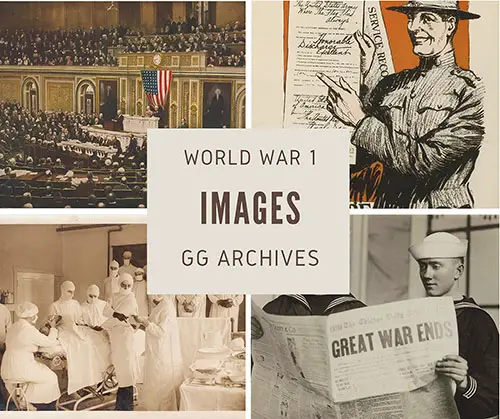
Photographs and Other Images of the Great War
The GG Archives has curated many photographs relating to World War 1, with most of the material created during the war (1914-1918). Some of these images deal with post-war topics such as transports home and the soldier's bonus.
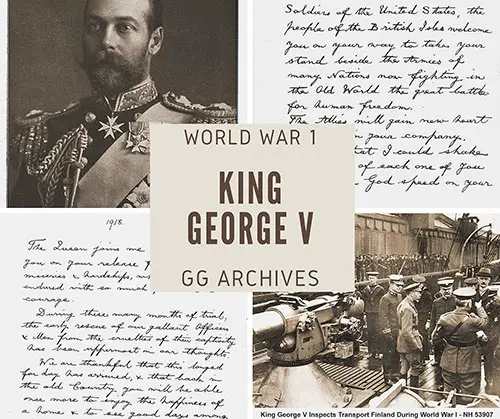
King George V in the Great War Including Correspondence and Photographs
Our unique collection includes photographs, letters, and biography of the English ruler, King George V.
- George V of England Biography
- King George V and the Great War
- King George V Letter to British POW's On Their Release in 1918
- King George V Letter to Soldiers of The United States - April 1918 (Including Valuation)
- King George V Photo Gallery
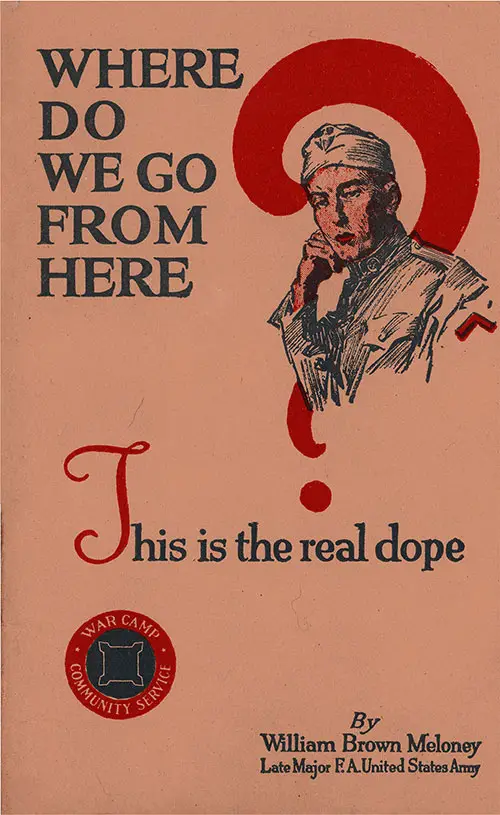
Life After Discharge - The Real Dope
William Brown Meloney, who wrote this handbook for soldiers: Where Do We Go From Here? The War Department published five million copies for Soldiers, Sailors, and Marines By War Camp Community Service.
- Educational and Professional Opportunities for Discharged Servicemen
- Getting a Job After Serving in the Great War
- Government Programs & Training After Discharge
- Living Off the Land - Options for Dicharged Soldiers and Sailors
- Options for Discharged Service Members
- Re-Enlistment Options for Servicemen in the Great War
- Soldier & Sailor Money Matters After Discharge
- Military Uniform After Discharge or Reserve Status
- Victory Medals, Decorations, and Liberty Belts
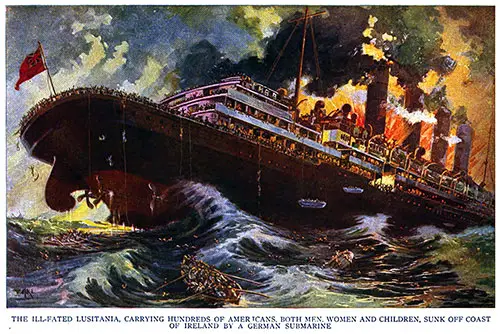
Our collection about the SS Lusitania of the Cunard Line includes articles and books about the sinking of the great and luxurious ocean liner by the German U-Boat and the aftermath that caused the US to enter World War I.
- America Entangled: The Story of the Lusitania
- Loss of the Steamship Lusitania
- The Loss of The Lusitania
- The Sinking of the Cunard Line RMS Lusitania
- The Sinking of the Lusitania
- Sinking of the Cunard Liner Lusitania Timeline

Based on the Booklet "Our Navy's Part in the Great War" by John Wilber Jenkins, this section organizes the content and supplements the text with additional photographs to help tell the US Navy's story in World War 1.
- 2,000 Vessels in Service When War Ended
- Alcedo Sunk by Torpedo - 1917
- American Naval Fleet Sent Over There
- "Cassin," Hit by Torpedo, Saved by Quick Action
- German U-Boats on American Coast
- Our Navy in the Great War
- US Naval Fleet in the Great War
- US Navy - Our First Line of Defense
- US Navy's Growth and Expansion During the Great War
- US Navy Ship Construction Program
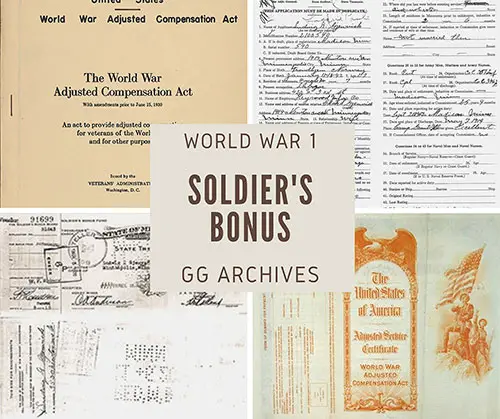
Soldier's Bonus / The Bonus Army of World War 1
Our collection of documents in this section are from the Gjenvick-Gjønvik Family Archives and other sources. The papers include certificates, vouchers, and payments of the Adjusted Compensation Act and the Minnesota Soldier's Bonus.
- The States and The Soldier Bonus
- Calculations of Adjusted Compensation for WW1 Soldiers - 1924
- Estimated Cost of Soldiers' Bonus HR 7959 - 1924
- Cost of Adjusted Compensation Provision HR 7959 - 1924
- Bill HR 15779 World War Veterans' Act As Amended - 1931
- World War 1 Adjusted Compensation Act As Amended - 1926/1932
- History of Adjusted Compensation - Veterans' Administration - 1936
- Discharged Soldier's Bonus - 1919
- Application For Adjusted Compensation For Service in the Army - 1924
- Adjusted Service Certificates Transmission Letter and Certificate - 1925
- Receipt for Application for Settlement - Adjusted Service Certificate - 1936
- Interim Receipt for Adjusted Service Bonds Surrendered for Payment - 1936
- Transmittal for Payment of Adjusted Service Bonds - 1936
- History of Minnesota Bonus for Veterans of World War I
- Minnesota Soldiers' Bonus Program Statutory History 1919-1924
- Minnesota Application for Soldiers' Bonus - 1919
- Minnesota Soldiers' Bonus Board Notification of Receipt for Bonus Application
- The Soldiers Bonus Board Voucher - State of Minnesota Soldier's Bonus Fund - 1920
- Bonus Expeditionary Force - BEF
- Walter W. Waters, Commander of the Bonus Expeditionary Force
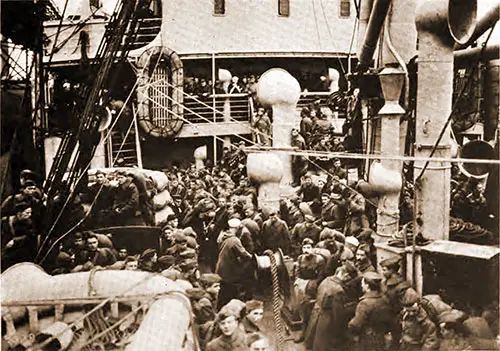
Transport Ships and Voyages of World War 1
The arrival of the first convoy carrying the soldiers and Marines of the American Expeditionary Force at Saint-Nazaire, France, on 26 June 1917 surprised the world and provided much-needed encouragement to the allies.
- Army Charted Transport Finland Struck by Torpedo
- Loss of the USS President Lincoln
- Moving Our Troops Overseas
- Saving the Transport Ship Covington
- Summary of Transport Operations During World War 1
- Transport "Antilles" Sunk by Submarine
- Voyage on the Transport Ship "Princess Matoika" during July 1918

World War 1 Infantry Unit Histories
One of the several purposes of this work is the promotion of esprit de corps within the Army units. Another is the furthering of interest in and the reading of military history by the American people.
- Unit Histories of the 351st Infantry, 88th Division
- Unit Histories of the 346th Infantry, 87th Division
- 88th Division
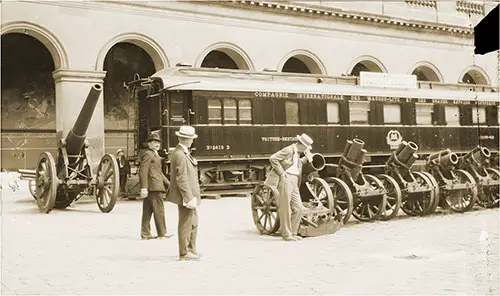
The United States sent more than a million troops to Europe, where they encountered a war unlike any other—one waged at sea, in trenches, and the air.
- Announcing the Armistice in America
- "Armistice Day" Traffic The Freak Demands that Marked Service on 11 November 1918
- Casualties of the Great War
- President Wilson's Address Announcing An Armistice
- The Armistice, November 11, 1918
- The Armistice - A Story for Homeward Bound Americans
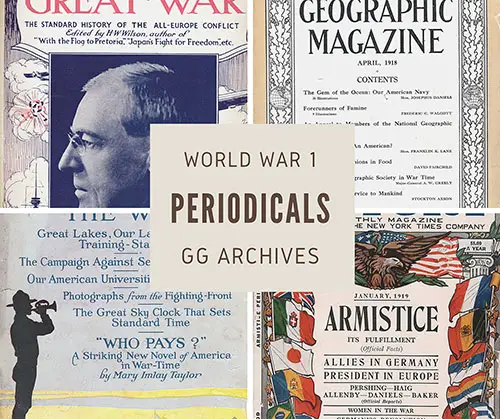
World War 1 Periodcal Collection
From Camp Newspapers, Great Lakes Recruit, The Great War Magazine, Current History Magazine, and others, the GG Archives has curated a historically valuable collection of periodicals covering the Great War.
- Camp Dix Pictorial Review - Issues from September 1917, 20 February 1918, 20 March 1918, 20 April 1918, 20 May 1918, 20 June 1918, 20 July 1918, and 20 October 1918.
- Character Building by Uncle Sam - 1918
- Great Lakes Recruit Magazine - September 1918
- The Great War, Part 143, 12 May 1917
- St. Nicholas Magazine for Boys and Girls - May 1919
- St. Nicholas Magazine for Boys and Girls - July 1919
- The National Geographic Magazine - November 1917
- The National Geographic Magazine - March 1918
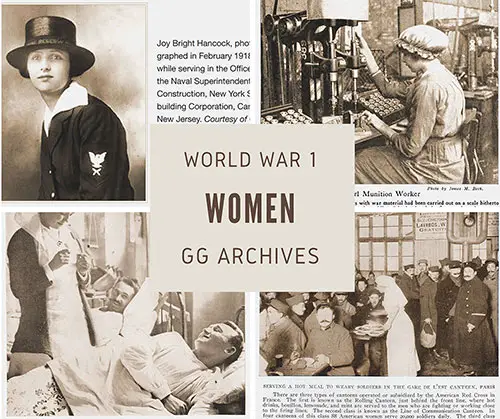
Women in the Great War - World War I
World War I was the first war in which American women were recruited to serve in the military. Women were already present in France as members of the American Red Cross and as canteen workers.
- Girl Patriots At Great Lakes
- Homes Wanted For American Women in France
- Navy Women of World War One
- The Symbol of Service to Mankind – The American Red Cross
- The Red Cross Nurse
- The Red Cross Organization During The War
- USN First Enlisted Women: Introduction
- USN First Enlisted Women: Setting the Stage
- USN First Enlisted Women: "Women Join the Navy"
- USN First Enlisted Women: "Reporting to Work"
- USN First Enlisted Women: "Changing the World, Their Lives, and the Navy"
- USN First Enlisted Women: Conclusion
- USN First Enlisted Women: Epilogue
- US Signal Corps Unit At Headquarters
- War Work of the Hostess House Committee
- War Work of Young Women's Christian Association
- What Peace Means To The YWCA
- Women Marines in World War I
- A Yeomenette Story From the Great War
